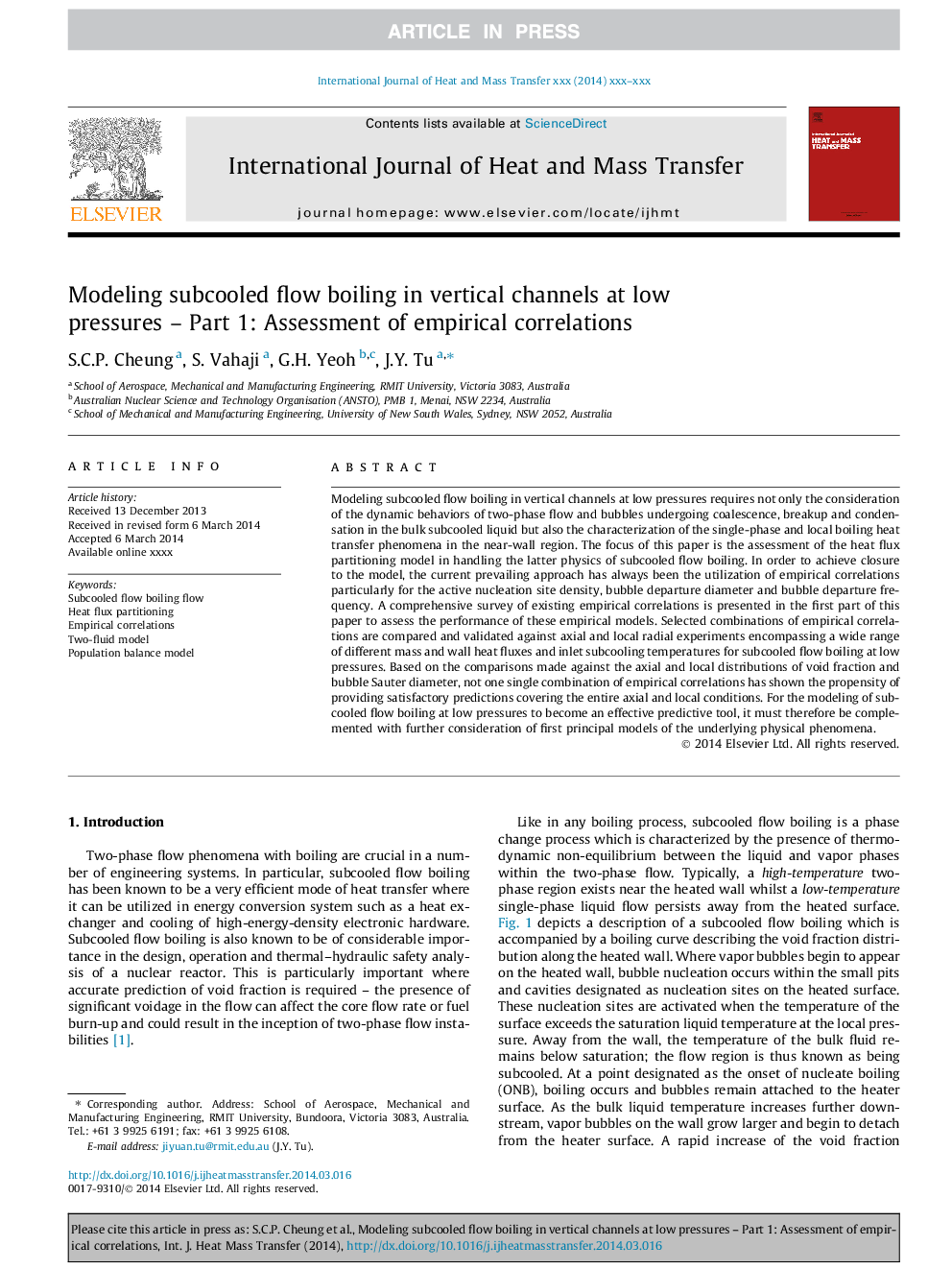| کد مقاله | کد نشریه | سال انتشار | مقاله انگلیسی | نسخه تمام متن |
|---|---|---|---|---|
| 7057159 | 1458067 | 2014 | 18 صفحه PDF | دانلود رایگان |
عنوان انگلیسی مقاله ISI
Modeling subcooled flow boiling in vertical channels at low pressures - Part 1: Assessment of empirical correlations
ترجمه فارسی عنوان
مدل سازی جوش جریان سوپاپوالکتر در کانال های عمودی در فشار کم - قسمت 1: ارزیابی همبستگی تجربی
دانلود مقاله + سفارش ترجمه
دانلود مقاله ISI انگلیسی
رایگان برای ایرانیان
کلمات کلیدی
جریان جریان زیرجلدی، پراکندگی جریان شار حرارت، همبستگی تجربی، دو مدل مایع، مدل تعادل جمعیتی،
ترجمه چکیده
مدل سازی جوش جریان متقابل شعاعی در کانال های عمودی در فشار کم، نیازمند صرف نظر از رفتارهای پویا جریان دو فاز و حباب هایی است که در اثر انحلال، تخریب و تراکم در مایعات سوپاپالیزه می شوند، بلکه ویژگی های حرارت جوش تک فاز و محلی پدیده انتقال در منطقه نزدیک دیوار. تمرکز این مقاله، ارزیابی مدل پارتیشن بندی جریان شار حرارتی در دست زدن به فیزیک دوم جریان جوش داده شده است. به منظور دستیابی به بسته شدن مدل، رویکرد غالب فعلی همواره استفاده از همبستگی تجربی به ویژه برای چگالی محلول سازی فعال، قطر خروج حباب و فرکانس خروج حباب است. یک بررسی جامع از همبستگی تجربی موجود در بخش اول این مقاله برای ارزیابی عملکرد این مدل های تجربی ارائه شده است. ترکیبات انتخاب شده از همبستگی تجربی در مقایسه با آزمایش های شعاعی محوری و محلی که شامل طیف گسترده ای از جرم های متفاوت جرم و دیواره حرارت و دمای سوپروایزر ورودی برای جوش خوردن جوش خورده تحت فشار کم هستند، مقایسه و تایید می شوند. بر اساس مقایسه های انجام شده براساس توزیع محوری و محلی قطر حباب و قطر سائر حباب، هیچ یک ترکیبی از همبستگی تجربی نشان نداد که تمایل به ارائه پیش بینی های رضایت بخش را پوشش تمام شرایط محوری و محلی نشان می دهد. برای مدل سازی جوش جریان سوپاپالیزه شده در فشار کم جهت تبدیل شدن به یک ابزار پیش بینی کننده موثر، باید با توجه بیشتر به مدل های اصلی اولیه پدیده های فیزیکی پایه، تکمیل شود.
موضوعات مرتبط
مهندسی و علوم پایه
مهندسی شیمی
جریان سیال و فرایندهای انتقال
چکیده انگلیسی
Modeling subcooled flow boiling in vertical channels at low pressures requires not only the consideration of the dynamic behaviors of two-phase flow and bubbles undergoing coalescence, breakup and condensation in the bulk subcooled liquid but also the characterization of the single-phase and local boiling heat transfer phenomena in the near-wall region. The focus of this paper is the assessment of the heat flux partitioning model in handling the latter physics of subcooled flow boiling. In order to achieve closure to the model, the current prevailing approach has always been the utilization of empirical correlations particularly for the active nucleation site density, bubble departure diameter and bubble departure frequency. A comprehensive survey of existing empirical correlations is presented in the first part of this paper to assess the performance of these empirical models. Selected combinations of empirical correlations are compared and validated against axial and local radial experiments encompassing a wide range of different mass and wall heat fluxes and inlet subcooling temperatures for subcooled flow boiling at low pressures. Based on the comparisons made against the axial and local distributions of void fraction and bubble Sauter diameter, not one single combination of empirical correlations has shown the propensity of providing satisfactory predictions covering the entire axial and local conditions. For the modeling of subcooled flow boiling at low pressures to become an effective predictive tool, it must therefore be complemented with further consideration of first principal models of the underlying physical phenomena.
ناشر
Database: Elsevier - ScienceDirect (ساینس دایرکت)
Journal: International Journal of Heat and Mass Transfer - Volume 75, August 2014, Pages 736-753
Journal: International Journal of Heat and Mass Transfer - Volume 75, August 2014, Pages 736-753
نویسندگان
S.C.P. Cheung, S. Vahaji, G.H. Yeoh, J.Y. Tu,
